There are 8 species of turtles in New Hampshire that can be found in the quaint wilderness, so long as you don’t mind the long, cold winters there. There are abundant Painted turtles and Common Snapping turtles as well as extremely rare Wood, Blanding’s, and Eastern Box turtles wandering in the wilds of the Granite State.
Four species of turtles are considered endangered in the state and cannot be taken, these include the Spotted, Blanding’s, Eastern Box, and the Wood turtle. The other 3 native species can be taken from the wild when following proper procedures and with a special license or permit.
While this guide serves as a herping guide, or to help you decide on which pet to get, we always recommend finding a respectable, licensed breeder to supply you with a turtle pet. Taking wild turtles as pets stresses the animal out considerably, and usually shortens its life drastically.
Captive bred animals are used to being taken care of by humans and do better as pets than they would in the wild. Besides, turtles are a vital part of any ecosystem, and removing them does have an impact on the delicate natural balance as they are beneficial to the environment.
Now, let’s take a look at the eight species of turtles in New Hampshire.
Table of Contents
Turtles in New Hampshire
1. Blanding’s Turtle
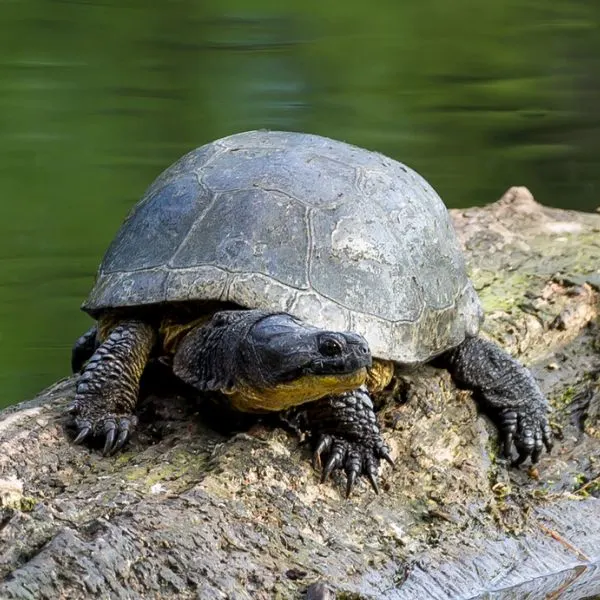
- Experience Level: Intermediate
- Family: Emydidae
- Scientific Name: Emydoidea blandingii
- Other Names: N/A
- Adult Size: 5 to 8 inches
- Life Span: Up to 80 years
- Average Price Range: $300 to $450
- Conservation Status: Endangered
Blanding’s turtles are medium sized turtles that can be found in the southeastern region of New Hampshire. These turtles are considered endangered in the state as their numbers are declining.
Habitat loss and road mortalities are the leading factors in their decline. These turtles prefer stagnant waters of bogs, swamps, wetlands, and marshes where there is plenty of vegetation and insects.
These turtles have a highly domed, dark brown to black shell with small, pale, yellow spots. The bottom shell, often called the plastron, is tan, cream, or yellowish with varying degrees of black smudges.
The most distinguishing characteristic of this turtle is its bright yellow chin and throat. The rest of the turtle’s exposed skin is dark, or black, so it’s easy to identify this turtle by that bright swath of yellow.
Blanding’s turtles spend as much time on land as they do in the water. They love to bask in the vegetation and will travel from waterway to waterway.
Blanding’s turtles are omnivores. They consume aquatic organisms such as crayfish, snails, and insects, as well as worms, slugs, and various plants such as duckweed.
Box Turtles in New Hampshire
2. Eastern Box Turtle
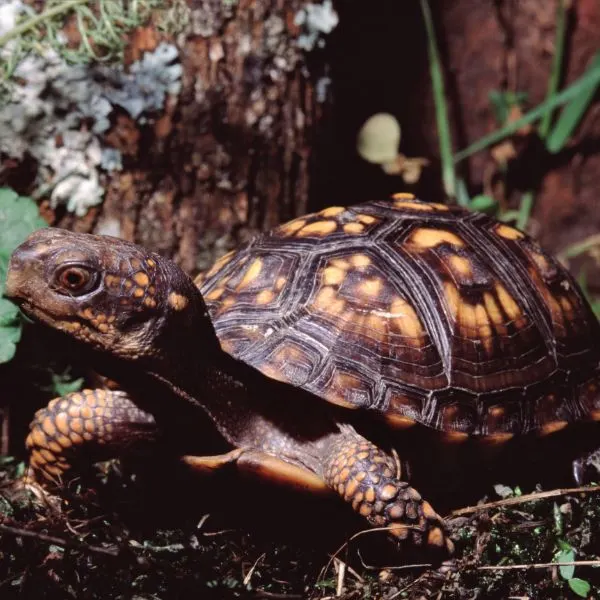
- Experience Level: Beginner
- Family: Emydidae
- Scientific Name: Terrapene carolina carolina
- Other Names: Land Turtle
- Adult Size: 4 to 7 inches
- Life Span: 50 to 100 years
- Average Price Range: $260 – $360
- Conservation Status: Michigan, New Hampshire, Massachusetts, and Connecticut—list the animal as a species of special concern, and Maine lists the turtle as endangered.
The Eastern Box turtle is New Hampshire’s rarest turtle species. While these native, terrestrial turtles were once relatively abundant, there are now only 2 monitored populations in the state.
Eastern Box turtles live on land, but like to be near waters such as small streams, wetlands, and ponds. They can swim, but they are more suited to life on land, and forest floors. Since they live on land, they don’t need to bask, instead, they will burrow into the soil, or under thick leaf litter to cool off.
When winter comes, these turtles will burrow into the soft, forest floor and hibernate. They usually start the process in October and will stay dormant until it warms up, either in April or May.
To identify these turtles, look for a highly domed, dark colored shell and yellow, orange, or reddish markings. These patterns vary widely between individuals, ranging from spots to streaks, and everything in between.
Their plastrons have 2 hinges that allow them to “box” themselves in their shell. It’s also pale tan colored with black or dark brown patterns. Their skin and scales are dark brown to black with the same colored patches and speckles as on the carapace.
The Eastern Box turtle is an omnivorous species that helps the environment by reducing insect populations and scavenging on carrion. They also eat fungi, berries, nuts, worms, snails, slugs, and some plants.
Musk Turtles in New Hampshire
3. Eastern Musk Turtle
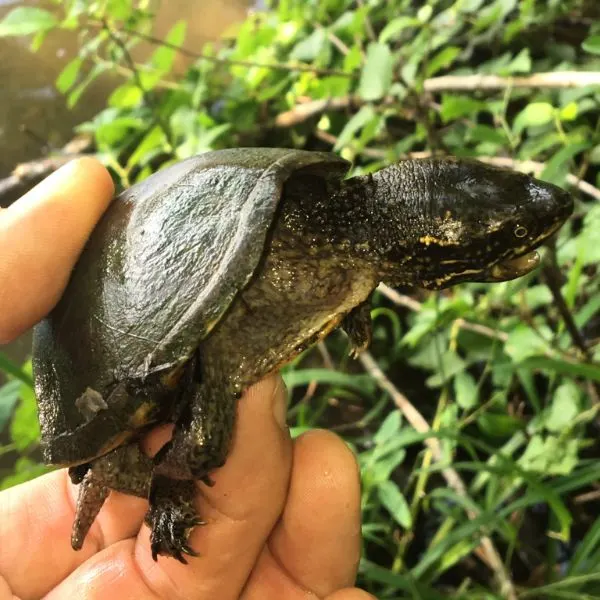
- Experience Level: Intermediate
- Family: Kinosternidae
- Scientific Name: Sternotherus odoratus
- Other Names: Common Musk turtle, Stinkpot
- Adult Size: 4 to 5 inches (10 to 12.5 cm)
- Life Span: 30 to 50 years
- Average Price Range: $30 to $120
- Conservation Status: Least concern
One of the smallest turtles found in New Hampshire, the Eastern Musk turtle only reaches around 4 to 4.5 inches in length. They are typically found in the southern reaches of the state.
Eastern Musk turtles prefer slow-moving waters such as ponds, bogs, and drainage ditches with a soft substrate and plenty of aquatic vegetation. They rarely bask, but they do come out of the water to climb up low reaching branches of trees.
Commonly referred to as “Stinkpots,” these little turtles have musk glands located near their hind legs. When they are threatened or disturbed by predators, they can release the potent odor as a defense mechanism.
Identify these little stinkers by their egg shaped, oval shells, pointed head, and two pairs of white or yellow stripes on either side of the head. These stripes run from the snout to the back of the head, and sometimes along the neck.
They also have fleshy barbels on their chin and throat. The upper shell is dark colored and patternless, while their plastron is hinged and brown. The Musk turtle can’t completely enclose itself like the Box turtle.
These turtles are mostly nocturnal and will feed on a wide variety of foods. They will consume leeches, fish, mollusks, crayfish, insects, worms, and vegetation.
Painted Turtles in New Hampshire
4. Eastern Painted Turtle
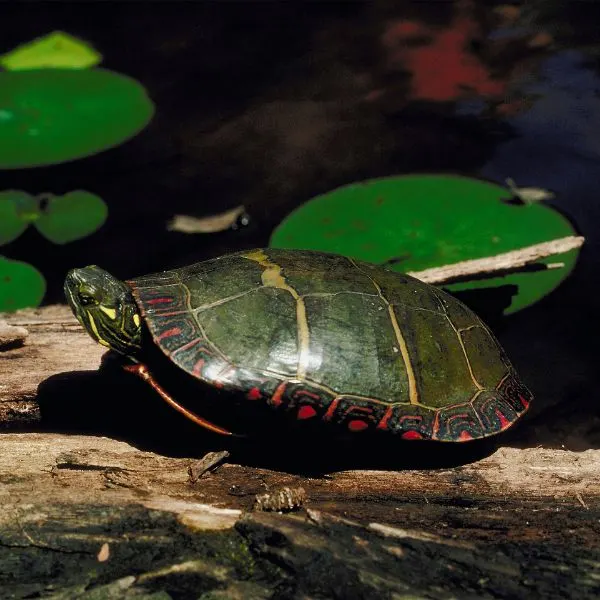
- Experience level: Beginner
- Family: Emydidae
- Scientific Name: Chrysemys picta
- Common Name: Painted Turtle
- Average Adult Size: 4 – 10 inches
- Life Span: 30 – 50 years
- Average Price Range: Between $30 to $150
- Conservation Status: Least Concern
Eastern Painted turtles have a smooth, dark colored carapace with straight lines running from front to back. These lines appear because of the way the scutes align. Scutes are the individual growth plates on the upper and lower shell of a turtle.
The outer edge of the turtle has more coloration and pattern than the top. The plastron is plain tan, or yellowish in color. This turtle’s skin is dark brown to black and covered with yellow and red stripes.
These turtles prefer bogs, ponds, slow-moving rivers, and shallow areas of large lakes. They need abundant basking spots as they spend a lot of time in the sun.
Painted turtles are the most abundant turtles in the U.S. In New Hampshire, the same is true, though they are a rare sight in the northernmost counties.
These mostly aquatic turtles are omnivores that help to keep insect populations in check. They eat plenty of mosquito larvae—especially juveniles—water spiders, mollusks, and aquatic vegetation.
Snapping Turtles in New Hampshire
5. Common Snapping Turtle
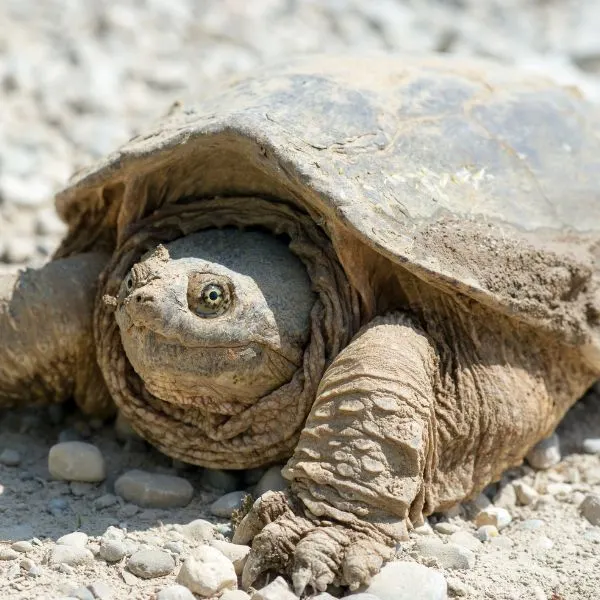
- Experience level: Intermediate to Expert
- Family: Chelydrida
- Scientific Name: Chelydra Serpentina
- Other Names: Snapping Turtle, Snapper, Eastern Snapping Turtle
- Average Adult Size: 8 to 20 inches
- Life Span: 30 – 50 years
- Average Price Range: Approximately $40 to $120
- Conservation Status: Least concern
Snapping turtles are the largest species of turtle in the Granite State. When you see one, you’ll know exactly what it is. These big beasts can get up to 20 inches long, just the shell, not including the long neck and trailing tail.
They stand up on wide legs that end in thick claws and have unexpectedly long necks. Their head is rounded and hook-like, and very sharp. They can bite out of the water, and if they catch hold of your skin, they can easily cut through skin and flesh.
Their carapace is olive, brown, or black. It may appear greenish, but that’s because of algae that often grow on their shells. Their skin can be yellow, muddy brown, or olive colored, while the underside is pale, or white.
Common Snapping turtles can be found in large lakes, reservoirs, rivers with little current, and large ponds and swamps. They rarely bask, preferring to stay in the water where they feel safest. Sometimes they come to the surface and float just under the water to warm up before going back down.
During the mating season, females will leave the water and travel long distances to find new homes and proper nesting sites. Be careful and keep your eyes open when traveling the roads, as these turtles often meet their demise on roadways.
Common Snapping turtles are mostly carnivorous, feeding on fish, crayfish, amphibians, small turtles, and anything else they can get into their wide maws. They have a bad reputation for eating ducklings and other waterfowl, but there are only a few, sparse, official records of them eating birds. Snapping turtles are lethargic in the water and don’t want to chase their food.
Spotted Turtles in New Hampshire
6. Spotted Turtle

- Experience Level: Intermediate to Expert
- Family: Emydidae
- Scientific Name: Clemmys guttata
- Other Names: Polka-dot turtle, “Spotty”
- Adult Size: 4 to 5 inches
- Life Span: Males up to 65 years; females up to 110 years
- Average Price Range: $200 to $300
- Conservation Status: Endangered
Spotted turtles are very rare in New Hampshire, and endangered in the other states this turtle calls home. Habitat loss, pet trade poaching, road mortalities, and predators are taking their toll on this turtle’s numbers.
These turtles are beautiful with their black carapace and skin, and bright yellow spots on the upper shell, head, neck, limbs, and tail. Some turtles may have over 100 spots on their shells, while others may only have a few or none at all.
Like the Blanding’s turtle, Spottys inhabit bogs, marshes, vernal pools, and wetlands with soft ground and abundant vegetation. These turtles spend time on land and in the water, but will only feed in the water, so a proper watery habitat is essential.
Spotted turtles are omnivorous and feed on crayfish, worms, insects, snails, slugs, plants, fish, and tadpoles. If they find terrestrial insects and worms, they will return them to the water and eat them.
Wood Turtles in New Hampshire
7. Wood Turtle
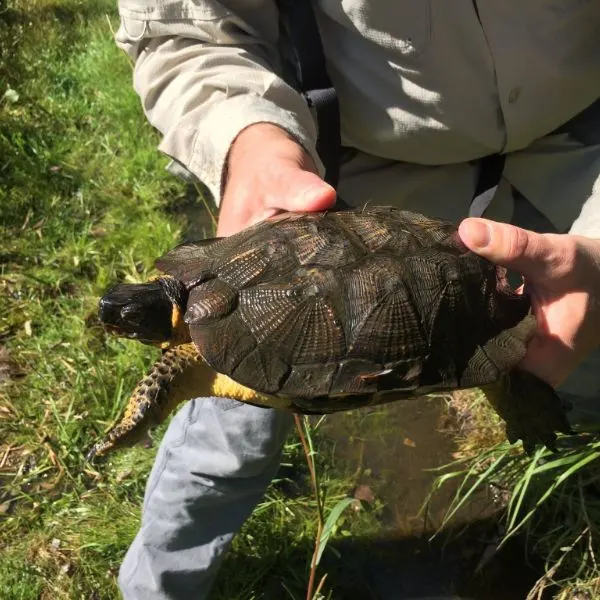
- Experience Level: Intermediate
- Family: Emydidae
- Scientific Name: Glyptemys insculpta
- Other Names: N/A
- Adult Size: 5.5 to 9 inches
- Life Span: 40 to 60 years
- Average Price Range: $250 to $500
- Conservation Status: Endangered
Finally, we come across one of the most interesting turtles found in the entire nation (at least in my humble opinion). The Wood turtle is a medium sized turtle that looks like it was crafted by an exceptionally talented woodcarver.
The upper shell of the Wood turtle is golden to dark brown, has growth rings and ridges that resemble wood grain, and the scutes are slightly pyramidal. The plastron is tan to light brown and has black on the scutes at the outer edges.
The exposed skin and scales are dark brown on the upper and outer edges and can be orange or reddish on the undersides. This reddish coloration on the legs gives them the nickname “red legs turtle.”
These turtles are mostly terrestrial, but spend time in shallow, clear waters and stay close to small streams, ponds, and marshes.
These turtles are quite intelligent and have figured out how to make earthworms emerge from their deep, earthy burrows. The wood turtle will stop its feet and shell to make it sound like rain. Earthworms come to the surface during rain showers, and when they emerge, the Wood turtle is there to gobble the worms up.
Aside from worms, this turtle feeds on millipedes, caterpillars, insects, mushrooms, berries, plants, leaves, flowers, moss, and carrion.
Pond Sliders in New Hampshire
8. Red Eared Slider
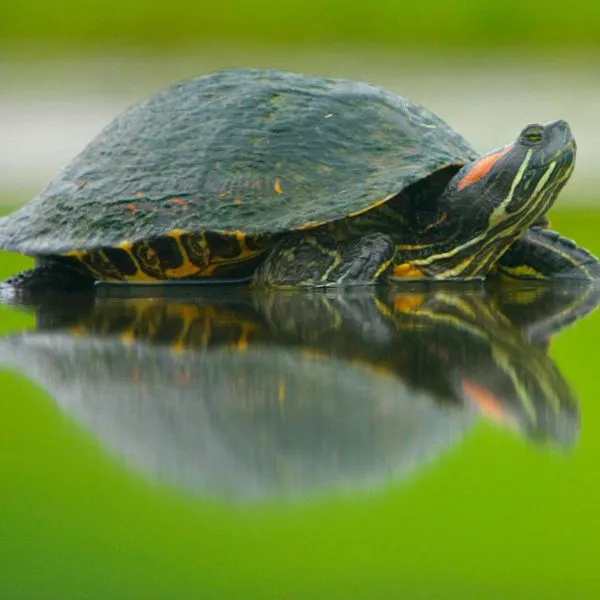
- Experience level: Beginner
- Family: Emydidae
- Scientific Name: Trachemys scripta elegans
- Common Name: Pond slider, Red-eared terrapin, Water slider
- Average Adult Size: 6 – 8 inches
- Life Span: 20 to 40 years
- Average Price Range: approximately $30 to $100
- Conservation Status: Least concern
Red Eared Sliders are good looking turtles with olive shells that are covered in various colors. The lower shell is tan colored with a few to several black smudges. Their skin is dark brown, olive, or black with yellow stripes very similar to Painted turtles, and red ovals behind the eyes.
They are extremely popular pet turtle species, but over time, people who aren’t prepared for the care these turtles need, end up releasing them into the wild.
In New Hampshire, Red Eared Sliders are not natives and have been introduced by humans. The unfortunate reality is when these turtles get established in a new habitat, they quickly become invasive, and harm native turtle populations.
Red Eared Sliders will bully other turtles away from basking spots, consume their food, and outbreed them. If you see Red Eared Sliders in New Hampshire, you are encouraged to contact New Hampshire Fish and Game.
While these turtles can make due in nearly any waterway, they prefer warmer waters with slow currents such as large rivers, streams, and lakes. They love to bask, and will sometimes stack upon each other as they search for the best spot.
Red Eared Sliders are omnivores that will consume algae, plants, insects, fish, crayfish, mollusks, carrion, and other aquatic creatures.
FAQs
What turtles are protected in New Hampshire?
Four of New Hampshire’s turtle species are protected, these include Blanding’s turtle, Wood turtles, Spotted, and Eastern Box turtles. You cannot own these turtles in the state without getting the required permits first.
Other species including Common Snapping, Eastern Musk, and Painted turtles can be taken, but wild turtles don’t make good pets.
Wrapping up
Now that you know about all the turtle species that can be found in New Hampshire, you’ll be able to identify them when you see them while hiking or boating. Keep your eyes peeled and you may find each species we listed.
Turtles need our help if they are going to survive, so be mindful when you are driving because many turtles succumb to roadway fatalities. You can also help by helping to keep the environment and waterways clean.
If you are enjoying these lists and other articles, please take a few seconds to leave a comment. We love to hear from our readers, and so do the other herp enthusiasts.
Other nearby states
